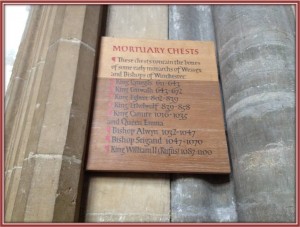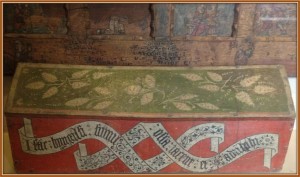On my recent trip to the UK as noted in my last post, I spent the better part of a day in Winchester Cathedral. Although I’ve visited this magnificent structure many times in the past, I’ve learned there’s always something new for me to discover and this visit was no exception.
Back in Chicago in preparation for writing my next book, ‘A Watch of Nightingales,’ I’d been grappling with making sense of historical reporting versus practicality surrounding the tomb of Henry II’s ‘fair Rosamund’ at Godstow Nunnery. From past research and experience I was aware of and have seen the many elaborate tombs created for persons of prominence as the United Kingdom’s churches and family chapels are full of them. For Arthurian enthusiasts, there even exists a detailed description of the massive black marble tomb created for the April 1279 reburial ceremony of Arthur and Guinevere at Glastonbury during the state visit by King Edward I and Eleanor of Castile.
However, in researching the ‘facts’ surrounding Rosamund’s placement in Godstow’s church and subsequent demand to have her remains moved by Bishop Hugh of Lincoln some 11 years later after her death, something wasn’t making any sense…until I discovered the mortuary chests at Winchester. My timing couldn’t have been more perfect due to the preparations for an extensive research project underway for the purpose of matching preserved bones to the early monarchs and bishops of the kingdom of Wessex, i.e, early Winchester.
To backtrack briefly here, one of the curators with whom I met, explained that when significant people died, their bodies were often left ‘open’ to natural decomposition. Once the process finished and the bones were the only remains, they were cleaned and then placed in ‘small mortuary chests’. Considering the non-existence of mortuary science as we know it today, such an approach was a very efficient means of preserving and honoring those who had passed. As to Winchester, this was the custom until Oliver Cromwell and his troops arrived. As we know from history, Cromwell and his men were ruthless when it came to destroying England’s history. Priceless artifacts were smashed, destroyed and scattered everywhere…the sacred bones of Wessex’s early leaders were no exception. In an effort to save what could be saved, the bones were gathered up and basically ‘dumped’ into various chests with frankly, no idea who belonged to what.
The goal of the current research project is to identify which bones belonged to which monarch and bishop; a formidable task but with the technology available today, perhaps not impossible. In any case this brings me back to the subject of mortuary chests; discovering their existence and how they were used solves my ‘technical’ dilemma regarding the conflict between Rosamund’s original tomb placement and the outrage of Lincoln’s very pious Hugh of Avalon. Stay tuned.
Photography©Gaye f. Mack, inc.


